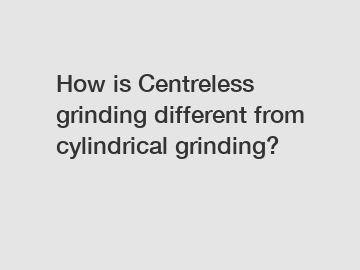Dec. 18, 2023
Minerals
Centreless grinding is a precision machining process that is commonly used in the manufacturing industry to produce smooth and consistent external cylindrical surfaces. While it may sound similar to cylindrical grinding, there are some key differences between the two processes. In this article, we will explore how centreless grinding differs from cylindrical grinding and why it is preferred for certain applications.
## Centreless Grinding: An Overview.
Centreless grinding is a machining process that does not require the use of a spindle or fixture to secure the workpiece. Instead, the workpiece is supported on a workrest blade, which is located between a grinding wheel and a regulating wheel. The grinding wheel rotates at a high speed to remove material from the workpiece, while the regulating wheel controls the speed and feed rate of the workpiece.

## Benefits of Centreless Grinding.
Centreless grinding offers several advantages over cylindrical grinding, making it a preferred choice for certain applications. Some of the main benefits include:
### Higher Productivity.
One significant advantage of centreless grinding is its ability to process multiple workpieces simultaneously. Since the workpieces are supported by the workrest blade and do not require individual clamping, more components can be ground in a shorter period. This leads to increased productivity and a faster turnaround time.
### Improved Surface Finish.
Centreless grinding is known for producing excellent surface finishes. The use of a rotating grinding wheel, combined with the precise control of the regulating wheel, ensures that the workpiece receives a consistent and smooth finish. This makes it ideal for applications where aesthetic appeal is essential, such as in the production of automotive parts or medical devices.
### Cost Savings.
Further reading:Due to its high productivity and efficiency, centreless grinding can result in significant cost savings for manufacturers. The ability to process multiple workpieces simultaneously reduces labor costs, while the consistent surface finish eliminates the need for additional polishing or finishing operations. Moreover, the elimination of a spindle and fixture reduces equipment costs, making centreless grinding a cost-effective option.
## Understanding the Differences: Centreless vs Cylindrical Grinding.
### Workpiece Support.
In cylindrical grinding, the workpiece is typically held in place by a fixture or spindle, which rotates the workpiece while the grinding wheel removes material. On the other hand, centreless grinding does not require the use of a fixture or spindle. The workpiece is supported by a workrest blade, and the grinding wheel and regulating wheel apply the necessary force to remove material.
### Precision and Tolerance Control.
Cylindrical grinding typically offers higher precision and tighter tolerance control compared to centreless grinding due to the use of a fixture or spindle. However, centreless grinding is suitable for applications where tighter tolerances are not critical. It is often used for grinding large quantities of cylindrical components that require a lower level of precision.
### Flexibility.
Centreless grinding offers greater flexibility compared to cylindrical grinding. Since there is no need for a fixture, different types and sizes of workpieces can be easily accommodated. This flexibility makes centreless grinding a versatile process that can be used for various applications across different industries.
In conclusion, while centreless grinding and cylindrical grinding are both machining processes used to produce cylindrical surfaces, there are several differences between the two. Centreless grinding offers higher productivity, improved surface finish, and cost savings. It is a flexible process that does not require a fixture and can accommodate various workpiece sizes and types. Therefore, it is crucial to understand the differences between these processes to determine which one is best suited for a specific application.
If you have any further questions or would like to learn more about centreless grinding or cylindrical grinding, please do not hesitate to contact us.
Contact us to discuss your requirements of custom stainless pipe united arab emirates, custom aluminium coil 7050, metal wire mesh nigeria. Our experienced sales team can help you identify the options that best suit your needs.
Further reading:Related Articles
If you are interested in sending in a Guest Blogger Submission,welcome to write for us!
All Comments ( 0 )